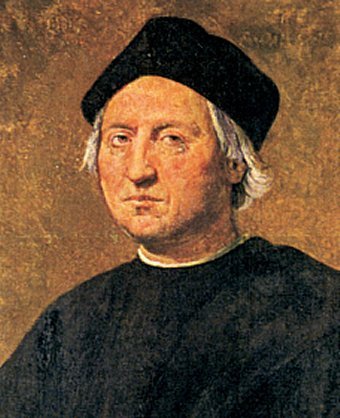The Question
© Charles ChandlerDespite the significance of Europeans coming to know of the American continents, for which Columbus gets the credit, there are a lot of misconceptions about how it all came to pass.It has been said that Columbus was the first to realize that the Earth is a sphere.1:ch.2 The credit for this actually goes to Pythagoras (). The idea was picked up by Aristotle (), after which it spread rapidly throughout the ancient world. Eratosthenes () calculated the circumference of the Earth to within 1% of the modern estimate.2,3 By the time Columbus came along a millenium and a half later, these calculations had been confirmed in many ways. So everybody knew that the "Indies" (i.e., India & China) could be reached by sailing west.And everybody knew that it would be much further going that way. But some considered the possibility that it would still be faster. Ships following the trade winds could make better time than pack animals on overland trails. So even though the distance might be greater, the voyage might still take less time.And then there was an ulterior motive for interest in a western route. Overland trade with the Far East was traveling through the Middle East, enriching the Pope's archrivals, the Ottoman Turks. By Columbus' time, the Catholics had given up trying to take the Middle East by brute force. The only alternative was to find a way around the Turkish Empire, by sea.The more conservative approach, financed by Portugal and led by Bartolomeu Dias in 1488, was to sail around the southern tip of Africa and into the Indian Ocean from there. Then there was the radical idea of attempting to reach the Indies by sailing west. Depending on the winds, either route might turn out to be the fastest.The biggest question concerning the western route was whether or not there were islands along the way, where the ships could replenish their supplies — otherwise they'd never make it. And since no ship that sailed west from Europe had ever returned, and since no explorer had ever come to Europe from the west, nor had any ship ever arrived in China coming from the east, it was thought that the Atlantic and the Pacific were actually just one huge ocean without islands in the middle, and thus far too big of an expanse to traverse with the ships of the day.Then Columbus appeared on the scene, with 10 pounds of religious devotion, 5 pounds of bad mathematics, and a request for 3 sturdy ships to explore the Atlantic for a possible western route to the Indies. If he succeeded, he was to be made admiral of Spanish navy, and governor of any new lands he "discovered," with rights to a percentage of the profits from trade through such lands.Ferdinand and Isabella were initially unimpressed, but finally agreed to the terms. Columbus' son later wrote that the monarchs didn't expect to see him again, so putting up the admiralty and provincial governorship as rewards constituted a safe promise for them. Surely Ferdinand and Isabella trusted their advisors, who knew that Columbus wasn't even close to a correct estimate of the distance. Perhaps they arranged the funding for the voyage just to prove their loyalty to the Pope, whose friendship was worth every bit of 3 sturdy ships and 1 Catalonian merchant captain. They may also have believed that if such a voyage could actually be made, it would only be by the conviction of a pious man, which Columbus was. For whatever reason, Columbus got his ships and supplies, and off he went.Upon the completion of his first voyage, he then showed Ferdinand and Isabella the "proof" that he had found islands just off the coast of the Indies, in the form of the "Indians" that he had captured. He then demanded that Ferdinand and Isabella make good on their promises. Never in his life did Columbus concede that he was wrong about the distance, and he therefore goes down in history as the brave and devout but mathematically-challenged sea captain who found the Americas, but never realized that they were not the Indies.But this doesn't exactly explain how Columbus effectively used his astrolabe to navigate to the Americas and back again, four times. Astrolabes were based on the principle that the Earth is round, and were calibrated based on the work of Eratosthenes. How, exactly, did Columbus trust his life to his astrolabe, and yet maintain to his death that he had found a western route to the Indies?
References
1. White, A. D. (1896): The Warfare Of Science With Theology. ⇧
2. Fischer, I. (1975): Another Look at Eratosthenes' and Posidonius' Determinations of the Earth's Circumference. Quarterly Journal of the Royal Astronomical Society, 16: 152-167 ⇧
3. Stern, D. P. (2004): The Round Earth and Christopher Columbus. nasa.gov ⇧











